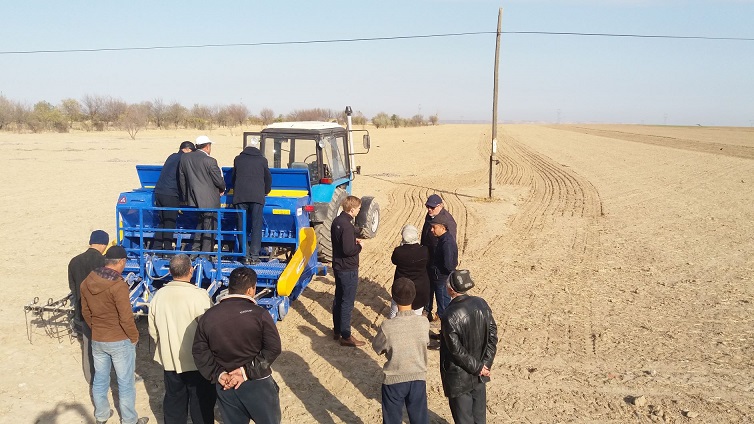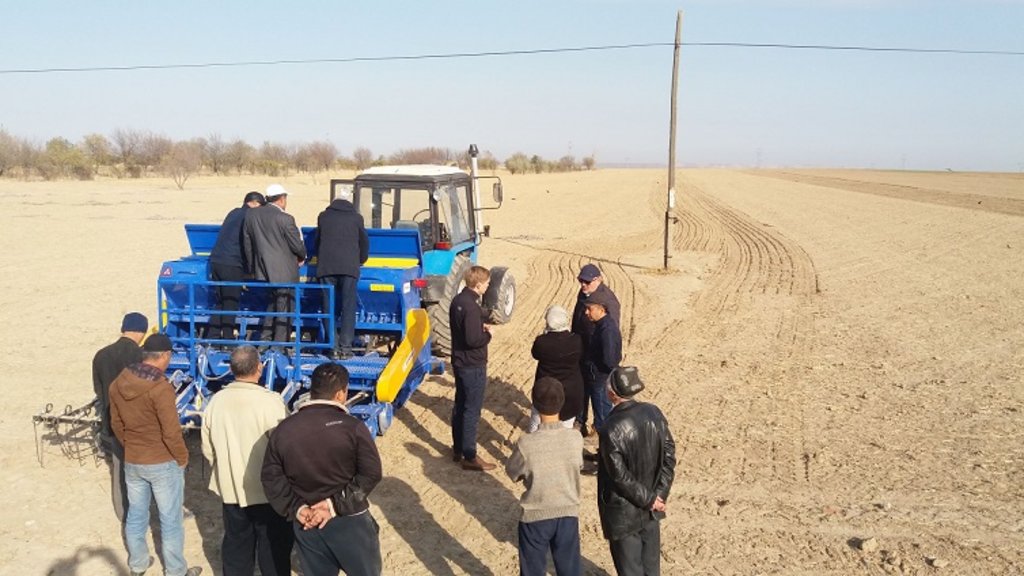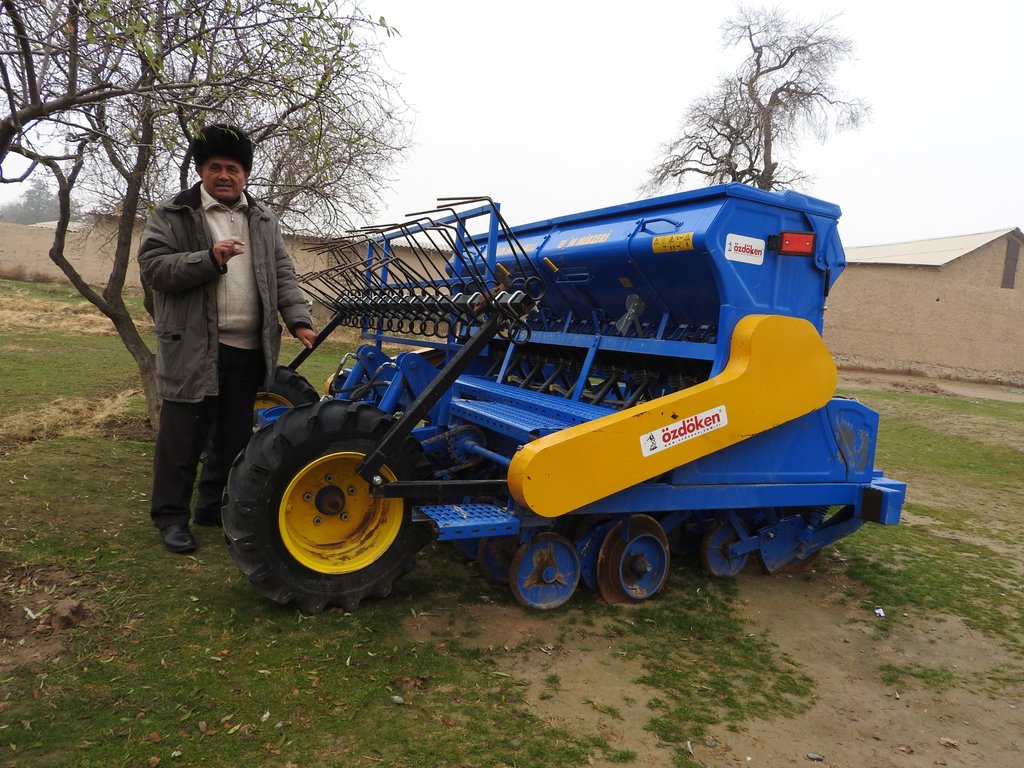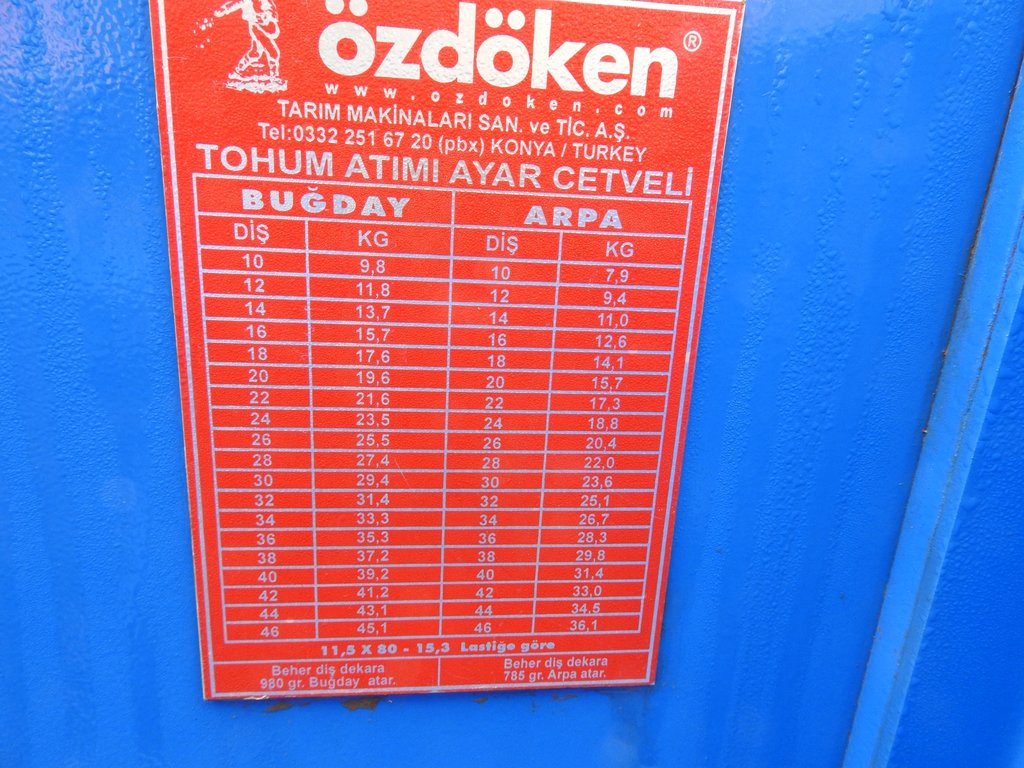Integrated rain-fed farming of cereals for adaptation to climate change [Таджикистан]
- Создание:
- Обновить:
- Составитель: Stefan Michel
- Редактор: –
- Рецензент: Umed Vahobov
Интегрированное ведение земледелия на богарных землях для адаптации к изменению климата
approaches_4317 - Таджикистан
Просмотреть разделы
Развернуть все Свернуть все1. Общая информация
1.2 Контактные данные специалистов и организаций, участвующих в описании и оценке Подхода
Ответственный (-ые) специалист (-ы)
Специалист по УЗП:
Negmatov Negmatjon
negmatdzhon.negmatov@giz.de
Deutsche Gesellschaft für Internationale Zusammenarbeit (GIZ)
Название проекта, содействовавшего документированию/оценке Подхода (если применимо)
Strengthening of Livelihoods through Climate Change Adaptation in Kyrgyzstan and TajikistanНазвание организации (-ий), содействовавших документированию/оценке Подхода (если применимо)
GIZ Tajikistan (GIZ Tajikistan) - Таджикистан1.3 Условия, регламентирующие использование собранных ВОКАТ данных
Когда были собраны данные (на местах)?
28/11/2018
Составитель и ответственный/-ые специалист(-ы) согласны с условиями, регламентирующими использование собранных ВОКАТ данных:
Да
1.4 Ссылка (-и) на Анкету (-ы) по Технологиям УЗП
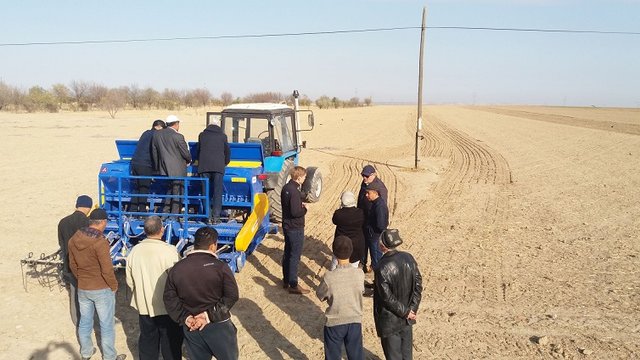
Applying zero tillage technology for climate change sensitive … [Таджикистан]
Direct sowing and application of fertilizer without ploughing reduces land degradation risks associated with conventional arable farming and saves costs for farmers while improving the resilience against climate change impact, in particular drought.
- Составитель: Stefan Michel
2. Описание Подхода УЗП
2.1 Краткое описание Подхода
Rain-fed agriculture faces challenges from climate change impact, inappropriate crop varieties and inadequate inputs. The approach of integrated rain-fed farming reduces the adverse effect of climate change impacts and improves the income of farmers.
2.2 Подробное описание Подхода
Подробное описание Подхода:
Rain-fed cultivation of wheat and other crops is hampered by poor agricultural practice and these challenges are increasingly exacerbated by the impact of climate change. The already visible trends and predictions show higher levels of aridity, higher temperatures during the vegetation season, reduced overall precipitation, more irregular rainfall patterns, reduced snow packs and accelerated snow melt. These factors all cause a reduced availability of moisture in soil during the growth season. Increasingly irregular rainfall patterns make it difficult for farmers to predict during the season of drilling if soil moisture will be sufficient for rain-fed farming.
Other problems in rain-fed farming are caused by inadequate agricultural practice. Crop varieties producing high yield of good quality under the local conditions of rain-fed fields are not available for local farmers. Classical tillage causes loss of humus content of topsoil, wind and water erosion and high evaporation. Insufficient knowledge about the use of agrochemicals, difficult access to these and financial shortages experienced by farmers during the time of planting and growing of crops cause the inadequate application of fertilizer and pesticides and cause crop losses and quality issues. Only wealthy farmers are able to purchase timely sufficient amounts of agricultural inputs. Most farmers apply insufficient amounts and inadequate combinations of fertilizers, thus contributing to the decline in soil fertility. Unreliable harvest amounts reduce the marketability of the agricultural products and cause low income levels of farmers, again affecting their ability to work their lands effectively and sustainable.
The approach aims at reducing these risks and obstacles in an integrated way under consideration of ongoing trends and predicted impacts of climate change. The approach therefore combines several elements through an agricultural extension service:
•Agricultural extension service providing tailored assistance to the farmers;
•Provision of agricultural inputs through the extension services to ease the application of technical advice and reduce transaction costs for the farmers;
•Packages of agricultural inputs include seeds/planting material, fertilizers and pesticides as well as growth regulator with the instruction for their correct use;
•The agricultural extension service provides access to crop varieties, which are adapted to the local site conditions and produce reliable high yields of best quality;
•Provision of machinery for drilling in combination with application of tailored amounts of fertilizer;
•Agricultural inputs are provided to farmers on a part loan basis by the extension service: farmers pay 50% of the costs of the package when purchasing, the remaining 50% are paid after harvest, with a zero interest rate (the extension service buys the inputs at bulk price and sells them to the farmers at retail price, which is 115% of the bulk price);
•Technological assistance includes cultivation technology like zero tillage and the use of modern drilling machines.
2.3 Фотографии, иллюстрирующие Подход
2.5 Страна/ регион/ место, где применялся Подход
Страна:
Таджикистан
Административная единица (Район/Область):
Sughd region
Более точная привязка места:
Devashtich and Istaravshan districts
Map
×2.6 Даты начала и окончания реализации Подхода
Год начала реализации:
2017
Если год начала реализации Подхода достоверно неизвестен, дайте примерную оценку:
менее 10 лет назад (недавняя)
2.7 Тип Подхода
- в рамках проекта/ программы
2.8 Каковы цели/ задачи Подхода
Improved agricultural productivity in terms of yields and quality under conditions of climate change.
2.9 Условия содействующие применению Технологии/ Технологий в рамках Подхода или затрудняющие его
Наличие/ доступность финансовых ресурсов и услуг
- затрудняют
Farmers have difficulties to afford agricultural inputs at the beginning of the growth season. This issue is addressed in the approach through part loans.
Институциональные условия
- содействуют
Agricultural extension service collaborates with GIZ and was ready to jointly develop and adopt the approach.
3. Участие и распределение ролей заинтересованных сторон
3.1 Заинтересованные стороны, участвующие в реализации Подхода и их роли
- местные землепользователи/ местные сообщества
Farmers
Applying the approach on their lands.
- эксперты по УЗП/ сельскому хозяйству
Agricultural experts
Providing technical advice.
- общественные организации
NGO "Agra va iqlim"
Agricultural extension service - advisory role, provision of inputs, purchase of drilling machine and its provision to farmers.
- местные власти
Agricultural department of Devashtich district
Interested in improvement of agricultural production and resulting well-being of the local population and economic prosperity of their districts. Political backing and support, provision of information, facilitation of contacts.
- международные организации
Deutsche Gesellschaft für Internationale Zusammenarbeit (GIZ)
Implementation of the project on behalf of the German government.
Если участвовало несколько заинтересованных сторон, назовите ведущую организацию:
Deutsche Gesellschaft für Internationale Zusammenarbeit (GIZ)
3.2 Участие местных землепользователей/ местных сообществ на разных стадиях реализации Подхода
| Участие местных землепользователей/ местных сообществ | Перечислите участников и опишите их вовлеченность | |
|---|---|---|
| инициирование/ мотивация | интерактивное | Discussion of testing of elements of the approach on their lands |
| планирование | интерактивное | Selection of land plots and discussion of testing of elements of the approach on their lands |
| выполнение | интерактивное | Applying elements of the appraoch on their lands |
| мониторинг/ оценка | интерактивное | Recording of yield and crop quality, reporting experiences in applying the elements of the approach. |
3.4 Принятие решений по выбору Технологии/ Технологий УЗП
Укажите, кто принимал решение по выбору применяемой Технологии/ Технологий:
- преимущественно специалисты по УЗП после консультаций с землепользователями
Поясните на чём было основано принятие решений:
- анализ подробно описанного опыта и знаний по УЗП (принятие решений на основе подтвержденных фактов)
- результаты исследований
- личный опыт и мнения (незадокументированные)
4. Техническая поддержка, повышение компетенций и управление знаниями
4.1 Повышение компетенций/ обучение
Проводилось ли обучение землепользователей/ других заинтересованных лиц?
Да
Тип обучения:
- опытные участки
- общие собрания
- курсы
4.2 Консультационные услуги
Есть ли у землепользователей возможность получать консультации?
Да
Укажите, где именно оказываются консультационные услуги:
- на полях землепользователей
4.3 Институциональная (организационная) поддержка
В ходе реализации Подхода были ли организованы новые институциональные структуры или поддержаны уже существующие?
- да, умеренно
Укажите уровень, на котором структуры были укреплены или вновь созданы:
- местные
Опишите организацию, функции и ответственность, членство и т.д.
Agricultural extension service developed as provider of package of agricultural inputs and machinery. Expanded its fields of work and reach of farmers.
Укажите тип поддержки:
- финансовая
- повышение компетенций/ обучение
- оборудование
Подробнее:
Drilling machine purchased for testing and demonstration. Income from provision of drilling machine will be used to purchase additiona machinery.
4.4 Мониторинг и оценка
Являются ли мониторинг и оценка частью Подхода?
Да
Комментарии:
Documentation of yields, recording of inputs, recording of return for machinery.
Если да, будет ли данный документ использоваться для мониторинга и оценки?
Нет
4.5 Научные исследования
Были ли научные исследования частью Подхода?
Нет
5. Финансирование и внешняя материальная поддержка
5.1 Годовой бюджет мероприятий по УЗП в рамках Подхода
Если точный годовой бюжет неизвестен, укажите примерный диапазон затрат:
- 10000-100000
Комментарий (например, основные источники финансирования/ ключевые доноры):
Government of Germany, implemented via Deutsche Gesellschaft für Internationale Zusammenarbeit (GIZ). The approach has been implemented in the frame of a much larger program and the specific budget for the SLM component of the Approach cannot be determined.
5.2 Финансирование и внешняя материальная поддержка, предоставляемая землепользователям
Предоставлялась ли землепользователям финансовая/ материальная поддержка для применения Технологии /Технологий?
Да
Если да, укажите тип(-ы) поддержки, кто ее предоставил и условия предоставления:
Loan of 50% of the costs of agricultural input packages, to be recovered after harvest at zero interest rate.
Drilling machine purchased with project support and thus available for farmers at lower cost than would be possible if purchased commercially.
5.3 Субсидии на отдельные затраты (включая оплату труда)
- оборудование
| Укажите, какие ресурсы были субсидированы | В какой степени | Опишите субсидии подробнее |
|---|---|---|
| техника | профинансированы частично | Drilling machine purchased with project support and thus available for farmers at lower cost than would be possible if purchased commercially. |
- сельскохозяйственные
| Укажите, какие ресурсы были субсидированы | В какой степени | Опишите субсидии подробнее |
|---|---|---|
| семена | профинансированы частично | Loan of 50% of the retail price of agricultural input packages, to be recovered after harvest at zero interest rate. |
| удобрения | профинансированы частично | Loan of 50% of the retail price of agricultural input packages, to be recovered after harvest at zero interest rate. |
| Pesticides | профинансированы частично | Loan of 50% of the retail price of agricultural input packages, to be recovered after harvest at zero interest rate. |
Если труд землепользователя был существенным вкладом, укажите, был ли этот вклад:
- добровольный
Комментарии:
Work on their own fields for their own income generation.
5.4 Кредитование
Предоставлялись ли в рамках Подхода кредиты на мероприятия УЗП?
Да
Укажите условия предоставления (процент, окупаемость и т.д.):
Loan of 50% of the retail price of agricultural input packages, to be recovered after harvest at zero interest rate. (The extension service buys the inputs at bulk price and sells them to the farmers at retail price, which is 115% of the bulk price.)
Перечислите кредитные организации:
Agricultural extension service / provider of agricultural inputs.
Перечислите заёмщиков:
Farmers
5.5 Другие методы или инструменты стимулирования
Использовались ли другие методы или инструменты стимулирования для продвижения Технологий УЗП?
Да
Если да, поясните:
The combination of advisory service, provision of a complete package of inputs and financial support (loan).
6. Анализ влияния и заключительные положения
6.1 Влияние Подхода
Сумел ли Подход расширить возможности местных землепользователей, повысить участие заинтересованных сторон?
- Нет
- Да, немного
- Да, умеренно
- Да, существенно
Participating farmers increased their confidence and status.
Сумел ли Подход дать возможность принимать решения на основе подтвержденных фактов?
- Нет
- Да, немного
- Да, умеренно
- Да, существенно
The direct link between the quality of agricultural input and practices and resulting yield and crop quality became visible.
Сумел ли Подход помочь землепользователям внедрить и поддерживать технологии УЗП?
- Нет
- Да, немного
- Да, умеренно
- Да, существенно
The farmers were enabled to apply technical advice from the extension service as necessary machinery was provided and agricultural inputs became easier available and affordable.
Сумел ли Подход мобилизовать/ расширить доступ к финансовым ресурсам для применения практик УЗП?
- Нет
- Да, немного
- Да, умеренно
- Да, существенно
Farmers were enabled through a part loan to purchase input packages. Machinery was made available through an extension service (NGO), which otherwise would not have the means of purchasing this machinery and provide it to farmers at affordable costs.
Сумел ли Подход расширить знания и возможности землепользователей в применении практик УЗП?
- Нет
- Да, немного
- Да, умеренно
- Да, существенно
Provision of targeted extension, demonstration plots showing the approach and its results.
Сумел ли Подход расширить знания и возможности других заинтересованных сторон?
- Нет
- Да, немного
- Да, умеренно
- Да, существенно
Involved extension service and agricultural departments gained knowledge.
Сумел ли Подход укрепить сотрудничество между заинтересоваными сторонами/ выстроить механизмы сотрудничества?
- Нет
- Да, немного
- Да, умеренно
- Да, существенно
Existing collaboration between farmers, extension services and agricultural departments consolidated.
Сумел ли Подход способствовать улучшению продовольственой безопасности/ качества питания?
- Нет
- Да, немного
- Да, умеренно
- Да, существенно
Increase in yields and reduced risk of crop failure.
Сумел ли Подход расширить доступ к рынкам?
- Нет
- Да, немного
- Да, умеренно
- Да, существенно
More reliable quantities of crop allow improved market access.
Сумел ли Подход улучшить способность землепользователей адаптироваться к изменениям климата и смягчать последствия катастрофических погодных явлений?
- Нет
- Да, немного
- Да, умеренно
- Да, существенно
Improved soil mositure, retained soil fertility, reduced erosion and adapted crop varieties reduce risk of crop failure caused by drought and allows for optimum yield under conditions of increasing aridity.
Сумел ли Подход привести к созданию новых рабочих мест/ к расширению возможностей получения дохода?
- Нет
- Да, немного
- Да, умеренно
- Да, существенно
Higher yields increase incomes of farmers. Reduced risk of crop failure makes farmers more economically resilient. Demand for inputs and machinery improves economic situation and employment opportunities of extension service.
6.2 Основные причины, побуждающие землепользователей внедрять УЗП
- рост продуктивности
- рост прибыли (доходности) и рентабельности
- снижение риска катастрофических погодных явлений
Reduced risk of drought caused crop failure.
6.3 Долгосрочная устойчивость мероприятий в рамках Подхода
Могут ли землепользователи самостоятельно (без внешней поддержки) продолжать применение того, что было реализовано в рамках Подхода?
- нет уверенности
Если нет или нет уверенности, объясните почему:
Many farmers will not be able to purchase the package of advise and inputs without loan support. Such loans are currently not available from commercial financial institutions at affordable conditions. Machinery for direct drilling and fertilizer application is only affordable for large farmers and service provider (extension service).
6.4 Сильные стороны/ преимущества Подхода
| Сильные стороны/ преимущества/ возможности по мнению землепользователей |
|---|
| Improved crop production. |
| Reduced risk of crop failure in case of drought. |
| Reduced costs for cultivation and fertilizer application. |
| Сильные стороны/ преимущества/ возможности по мнению составителя или других ключевых специалистов |
|---|
| Improved crop production effectiveness and cost efficiency. |
| Reduced risk of crop failure in case of drought. |
| Preservation of soil fertility. |
6.5 Слабые стороны/ недостатки Подхода и пути их преодоления
| Слабые стороны/ недостатки/ риски по мнению землепользователей | Возможные пути их преодоления/снижения? |
|---|---|
| High costs of inputs can by most farmers only be met with loan, at better conditions than typical commercial loans. | Loans at affordable conditions. |
| Dependence on extension service for use of machinery and potential availability issues. | Reinvestment of payments for machinery use in additional machinery as demand grows. |
| Слабые стороны/ недостатки/ риски по мнению составителя или ответственных специалистов | Возможные пути их преодоления/снижения? |
|---|---|
| High costs of inputs can by most farmers only be met with loan, at better conditions than typical commercial loans. | Loans at affordable conditions. |
| Dependence on extension service for use of machinery, potential availability issues and risk of monopoly situation. | Reinvestment of payments for machinery use in additional machinery as demand grows. Development of more service providers. |
7. Справочные материалы и ссылки
7.1 Методы сбора/источники информации
- выезды на места, полевые обследования
- опросы землепользователей
- опросы специалистов/экспертов по УЗП
- данные, собранные из отчетов и достоверных документов
Ссылки и модули
Развернуть все Свернуть всеСсылки

Applying zero tillage technology for climate change sensitive … [Таджикистан]
Direct sowing and application of fertilizer without ploughing reduces land degradation risks associated with conventional arable farming and saves costs for farmers while improving the resilience against climate change impact, in particular drought.
- Составитель: Stefan Michel
Модули
Нет модулей


